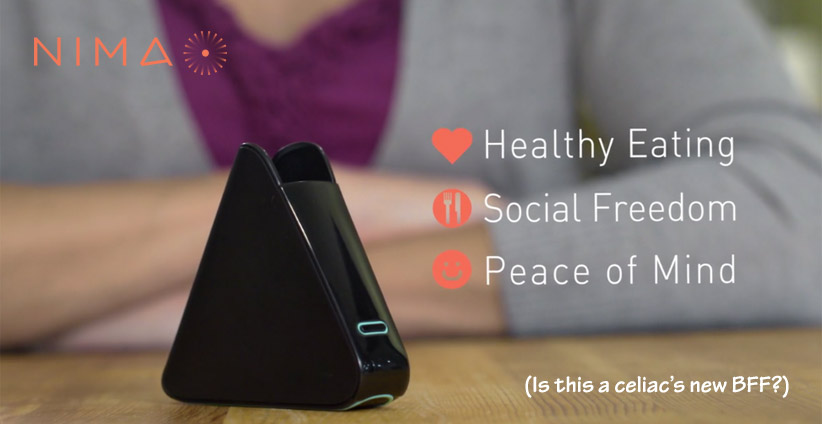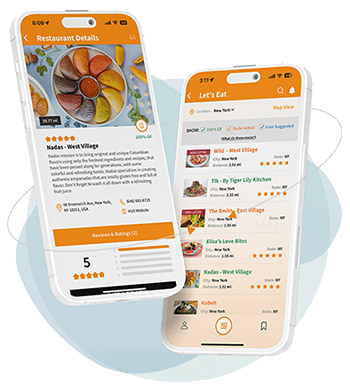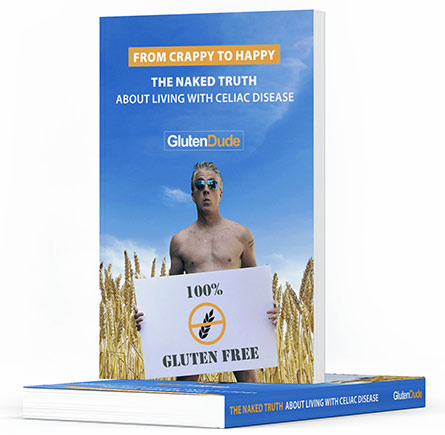So celiac kicked my ass last week (hence the unusual delay between blog posts). It’s the hardest I’ve been hit in some time. Crazy exhaustion, a few nights of insomnia, in a mental haze (not to be confused with a purple haze), and of course yelling at my dog because he wanted my attention. Yeah…that’s normal.
 My apologies for the down time.
My apologies for the down time.
So almost exactly one year ago today, I heard about a device being created by folks from MIT that could potentially detect gluten in food in two minutes or less. I was seriously intrigued so I reached out to the good folks at 6SensorLabs and they granted me an interview. You can read it here.
Well here we are a year later and the Nima Sensor is almost ready for prime time (you can place a pre-order here). I went up to NYC with a few other celiac advocates, met the 6SensorLabs team and saw the device in action. It was seriously cool. And get this…they had the event catered and the chef ensured everything was gluten-free. Before the event started, they tested each catered item with the Nima Sensor. Yep…one of the dishes failed. Kick save and a beauty.
Besides being “cool”, I came away with a few impressions:
- The 6SensorLabs folks are the real deal. Smart people with good hearts.
- The device could be revolutionary (as it will eventually test for other allergens as well.)
- I loved the simplicity of it.
- The sharing of the data on social media is HUGE and adds tons of value to the device.
I also came away with a few questions:
- Will people pay for it?
- Will people use it?
- Will restaurants care (if the results show a dish is NOT gluten-free)?
And this is where you folks come in. I reached out to the Nima Sensor founders and suggested we do a second interview now that the product is almost ready to market. They wanted to get specific feedback from the gluten-free community and suggested a survey instead. Good call! Without missing a beat, they came up with the below questions. They want to make sure they do this right and your answers will help.
Please consider taking a few minutes of your time and completing the survey. It would help them help us. Note there are 12 total questions. Thank you.
(If you do not see the survey embedded below, here is the direct link.)







I just don’t see the link to the survey? What am I missing?
I don’t see it either
I thought it was just me.
It’s embedded on the page, but perhaps it’s not showing for some. I’ve added the direct link above. Thanks for the heads up.
Here’s the link to the survey: https://www.surveymonkey.com/r/NimaGlutenDude
I just took the survey. Do you know how expensive the device will be?
I really want to know the answer to this too!
Their website should have all of the details…nimasensor.com
Will this device be independently tested for accuracy? What ppm will test positive? I assume multiple courses and drinks(wooheeeee!) would have to be individually tested. I also assume the chef will be pleased as a cat on a cactus when you send back their dish because it failed ‘The Test.’
Sorry you got whacked this week, Dude.
This is my concern as well. The Nima sensor is designed to test to the 20 ppm level required by the FDA, however this is not sensitive enough for many people. I understand the technological difficulties of testing lower, accurately, but I would much rather have seen this presented as at least a 10 ppm test, ideally, 5 ppm.
I took the survey, and there is an “ask the right question” issue. I REALLY don’t want an ELISA assay! The home kits that take 15 minutes don’t work. Also, what about the fragments of proteins that the test can’t see but my body can? I doubt I can get a pocket mass spectrometer. 😛
Took the survey. Cost of product? I would love to see what a restraunt would say when they advertise a GF meal and then it’s not. Eating out is the worst for me so I would be interested if this worked. Although a contraption that I put out on the table is just one more thing that makes me stick out being Celiac, but my health is more important. Thanks Gluten Dude, you are the best!
I love this idea! I travel for work and that seems to be when I get sick the most. Going to restaurants I’m not familiar with and having to trust they know what they’re doing.
I am excited about this and already pre-ordered. I was diagnosed with Celiac less than a year ago. I have gastrointestinal symptoms with gluten exposure, but it’s not severe. While I am grateful for that, it makes it more difficult to know if I have been exposed to gluten so I can avoid that food in the future. I do not want to repeatedly harm myself unknowingly. Every time I have gastrointestinal issues of any kind I am questioning everything I ate, but because the symptoms are not severe it’s possible that it was unrelated to gluten. I end up in a vicious cycle of questioning foods I thought were safe and trying them again and wondering if it was a coincidence or if the food really had some gluten. I feel like this device will help me get a better grasp on what is safe for me and what is not without this non-scientific trial-and-error method that may be harming me.
Also, there is nothing worse than ordering a meal at a restaurant where I have no control or view of the ingredients or how it was prepared and trusting that it is safe. I don’t want the device so I can point fingers at the restaurant, I want it so I can enjoy my meal without fear. Maybe it will bring some of the joy back to eating out (which I generally loathe now). If they can develop this for egg allergies, I might allow my daughter with a severe egg allergy to eat out someday!
On a side note, after reading your symptoms from the last week, I wonder if I have some of that going on. I know I was exposed to gluten this weekend (hasty label reading – first time I’ve done that and hopefully the last!). I have been tired, foggy, and cranky. I tend to blame that behavior on my thyroid, lack of sleep, or general disposition. 😉 Maybe there’s more to it.
Love this idea! Just took the survey. Can you tell us how it actually works? What the cost might be? Is it an instant read?
according to their website the Nima device will be $249 and the food capsules will be $59.95 for a pack of 12.
For something with an unreliable mechanical (only one sample from a whole plate) and chemical (faulty assays with limited scope) methodology, no thanks.
I do just fine at 100% dedicated gluten free restaurants and with bringing my own food. If I want ease, I throw a random dinner party at home. For >$300, that’s quite a shindig.
This is great! I’m dying to know what the failed dish was though. And I’m curious the cost on this little testing device.
Head over to their website for all the juicy details: https://nimasensor.com/
I’m really looking forward to seeing the reviews on this device. To be able to test foods at Thanksgiving, for example, to see if there’s anything I can join my family in eating would be amazing!
I thought about this too. While it would be nice to test at Thanksgiving, I would bet some people might be offended by you testing a dish you’re told “should be” gluten free. Last Thanksgiving I ate a meal with my husband’s family, and was told which things were supposed to be gluten free. There were maybe 3 or 4 things total, minus what I brought. I can’t remember now what they were other than the turkey and corn casserole. I was SEVERELY sick and it didn’t take long, to which I knew something was so clearly NOT gluten free. It doesn’t always come that quick for me. I haven’t eaten a meal there since. I know for certain if I brought this device to test foods in front of his mom, she’d freak out and get mad, albeit not say anything to my face. Most of my family and his, after more than 10 years, still don’t get it.
It sounds interesting and promising, but what if the gluten isn’t in the piece you put in the device? I wonder how well it can detect cross-contamination? Would it detect the amount of gluten that is present if the same pan is used (without cleaning)?
This is seriously the best thing I’ve seen in forever. I would buy this, no matter how expensive. Dude, there must have been something going on last week, b/c I got glutened somewhere mid-week and it was ugly. Hope you’re feeling better. I’m ready to go dancing….
Anyway, so excited about this item. Thanks for posting. Tweeting it out there so others know about it.
I have one possible problem with a device like this. Gluten contamination in a food product could appear right next to a portion of that food product that is not contaminated, correct? I mean, gluten protein at 20 ppm is really tiny, so that 20 ppm of gluten protein could be sitting in the west end of the gluten free food portion on your plate while not being in the east end of it, correct? (maybe this could happen from a gluten contaminated spoon touching the west end but not the east?) If that is the case, using a device such as this would require having to test each and every bite of food … correct? So … if that is the case, I would not be buying a device such as this. Now, if I could wave a wand over my plate of food to be told whether or not it had gluten in it, I would buy that product. But testing every bite of food before I eat it? No. I would rather just watch everyone else eat, or not go out to restaurants at all unless they are 100% gluten free restaurants. I just don’t take chances. I have learned that I can go a long time without food as long as I have water with me. Living this way is the only way I got my antibodies down within “normal” ranges. I fear that people would put too much faith in the product by testing a portion of their food and then trusting that the result was the same for the rest of it when, in actuality, unless every bite was tested there would be no guarantee that the device was actually telling you all the food on the plate is gluten free. If I have misunderstood how the device will work, please let me know. Thanks. Because of how I understand this device will work, I did not take the survey.
I’m with you, Deb. Plus, it looks like those unreliable, cheaper test strips with a digital sensor that jacks up the cost rather than a real testing innovation.
I’m with you as well, Deb. The only one I trust with my food is me.
I completely agree. While I think this is a huge step and it’s pretty cool, I don’t think it will be THAT helpful. Let’s think about a pizza alone. You could have 3/4 of the pizza that’s fine, but someone that had flour on their apron or their hands or something that just touched the edges of your pizza. If you don’t sample from that area, it will test fine. Or think about a salad. You’d have to put a piece of every single item in there to be sure nothing in it has gluten. You’d have to test your entire meal to know it’s not safe. It just doesn’t seem quite there yet for me to spend the money on it. The capsules are pretty small, so you wouldn’t be able to fit much in there, and who can afford to use multiple capsules on one meal? The idea is there. I just am not confident it’s quite ready to be sold, but alas, they are.
Gluten Dude – I’m curious to know if you feel like you would trust that this would realistically limit lessen the frequency of getting sick eating at restaurants for a celiac. The product’s website mentions limitations in identifying issues of cross-contamination since an entire plate of food is not analyzed, just a small sample. I often wonder when I get sick eating out if it was an issue of gluten ingredients in what I ordered or cross-contamination in the kitchen. I want to be excited about Nima, but I’m hesitant.
Here are my thoughts. I do think the product could be revolutionary and it’s being built for the right reasons. Will it guarantee you don’t get sick? Not necessarily, as your example provides. Will it help limit the possibilities of getting sick? I think it will. And of course, there is the price point. 6SensorLabs will need to determine what they think the community is willing to spend to reduce their risks.
I filled out the survey. Like most, I’d be skeptical if it could REALLY work, and last over time. Like Jen states, I can’t imagine how you’d detect CC in an entire plate of food. But . . . I’m all ears. 🙂
I agree wth Jen and Brian. I’m intrigued by the promise of this device but the inability of it to detect cross contamination is a serious problem.
This looks like an amazing product! Am I correct that you need a fresh capsule for each and every food sample? That is the only part as I see will get expensive. The price of the unit itself is fair. The refills are expensive. But I def like the technology to keep people safe! Well done!
What the what? Only 20 ppm. This is probably the unreliable ELISA test. What’s more, you can’t keep it in your car for when you are on the go or store it in any kind of heat. I really hope food companies don’t start using junk like this to test for “GFCO” status.
Dang…you left 3 straight comments, each more cynical than the previous one. You call it “junk” because it doesn’t measure up to whatever standards you have set for it? I’m more cynical of the business behind the “certifications” out there than I am of a company who is trying a new idea. I’m not saying the product will be perfect. I’m not telling people to go buy it. Everyone’s got to decide for themselves. But why the negativity?
I’m tired of people exploiting our community. This thread was inviting commentary, and I’m deeply cynical about this product. That’s my truth.
There are FAR TOO MANY companies out there exploiting our community. This company is trying to create a device that will help people with multiple food issues, not just gluten. Gluten just happens to be the one they are starting with. How is that exploitation?
You can be doubtful of a product’s effectiveness. The market will decide that. But to call it junk and question the company’s motives, with absolutely no knowledge whatsoever of the history or the facts, just comes across as unnecessarily negative.
This device does not test to the point of cross-contamination, so to me it does not do its job.
Sorry you got glutened. I hope you’re feeling better quick. Unfortunately that has been my point in several comments on this blog. In my opinion it’s no longer worth the risk to eat out. It has been a year and 7 months since the last time I got glutened and I’ve lost 10 lbs, now at 84lbs and haven’t been well since. I’ve developed multiplayer food sensitivities, and other auto immune diseases. I honestly believe that as a celiac you are putting your life at risk when you eat out. I don’t know if I will ever be well again. My primary care doctor seems to have given up. I go to an alternative MD for IV nutrition and other supplements and have spent thousands of dollars. The GF food industry is selling junk food just like main stream food corporations. They are making tons of money and making celiacs more sick because a lot of the grains and additives are as harmful to the gut as gluten is to a celiac. I wish I had known this why I was diagnosed, maybe I would still have a quality of life. So the little, very expensive device, would not make any difference to me as even the tiniest bit of gluten is unacceptable.
My thoughts about the device are pretty close to yours, GD. I love the idea and am excited about the potential for something like this, but all kinds of questions come up when I picture the real-life scenarios for using it. When I imagine using it in a restaurant, all I can think is that this will give the staff one more reason to despise me. (Waiter: “Chef, she’s testing your food. She’s taking pieces of it and sticking them into some thingie that says whether there’s gluten in them.”)
I can actually see myself using it more often to test packaged “gluten-free” foods in my own home before consuming them, or to test communal dishes prepared by family and friends — like the pâté my sister made, thinking that it would be OK for me to eat. (Thank God I spotted the empty carton of beef broth and asked, “Did you use this in the pâté?” “Yes. Why?” “Because it contains wheat.” “Oh, s***!”)
I don’t balk at the base price of the device, because I understand that it must have taken a significant amount of money to bring this product to market. But I can’t see myself using it very often when a dozen pods cost $60.
GD – Thanks for the article! It wasn’t clear to me whether it can give you a reading of levels, or just a smile or a frown. As an engineer, I tend to go for data, and I’d prefer to get some.
That said, it is promising. I will be very interested to hear how it works out. I took the survey and signed up for their mailing list.
There is a video out there that’s about 2 minutes, sort of giving you an idea of how it works, and it looks like it’s just a smile or a frown….no actual numbers. That would be interesting to know though!
Question 1 I wish I could have left a comment on. I almost never eat out for fear of cross contamination and unthinking or uncaring resturaunt staff. I used to work in a restaurant and I know how some of the staff responded to the people with food allergies. Heaven only knows how wait staff who think you are just being trendy are going to react but it can’t really be any worse. At the place I worked in the chef would just say, “yeah sure tell em it’s (fill in the blank). “
It’s an interesting idea, and I might purchase the product under certain circumstances (cost??). However, I’m not sure how feasible this would be for testing at restaurants. You’d have to test each component of your dish (vegetables could be fine, but what if the meat was grilled on a shared grill?) and even then, you could miss the specific *part* of the dish that had contamination (you test the salad, but NOT the piece of lettuce someone picked a crouton off of?). That said, it’s pretty cool that anyone is even TRYING to do something like this!
The pods are way too expensive. If they could get it down to a dollar a test, it would be okay for homogenized stuff, like a cream soup or a bag of some kind of flour. To really do the test right on a meal, you’d have to run the meal through a blender and test a sample of the resulting glop: no, thanks. I give them a lot of credit for trying, and they may even sell enough of them to make back their investment (hope they do), but I can’t see buying the device for my own use.
I would love to get one of these for my son before he goes off to college next year. I worry about the dorm food, even though most colleges say they offer safe food for anyone with food sensitivities. I wonder if insurance will ever pay for something like this.
It looks like a really interesting product on the surface, but I’ll admit, I have a lot of the same concerns that many other commenters here have. The price point for the refills seems very high, especially given that it only tests a portion of your food. It’s a cool idea in theory, and could well be a good jumping off point for someone (or the same company) to develop something that addresses the issues brought up about the higher 20ppm threshold, the limited sample size, and the high cost of replacement pods.
I think it might be most useful to use on drinks since they are typically all mixed together – so I could see using it so I could feel comfortable having a drink at the bar, for example, which is something I don’t currently do because of all the beers on tap and the potential for cross-contamination.
I haven’t gone back through the previous comments to see if anyone has asked this, but I’m actually curious about testing grain-free or gluten-free labeled pet foods. I’m not sure what standards might be in place, if any exist, for labeling pet foods gluten-free. Do manufacturers do any testing at all? The food I currently feed my cat is not labeled gluten-free but does not contain gluten ingredients. However, I found out the hard way that it’s contaminated. I try to keep all her stuff segregated, and in the fridge, her covered can of food is placed on a saucer and kept as far away from my foodstuffs as possible. I don’t even clean her food dishes in the kitchen sink (I have another location I use), and I fix up her food on the floor where she eats rather than on the counter. I would be just as cautious and careful with foods labeled grain-free or gluten-free because I just don’t know what these terms mean on pet food. I don’t see the point in changing her food, for this reason and because she likes what I feed her currently. However, if I could find a gluten-free pet food that actually tested as such, I might be tempted to try switching.